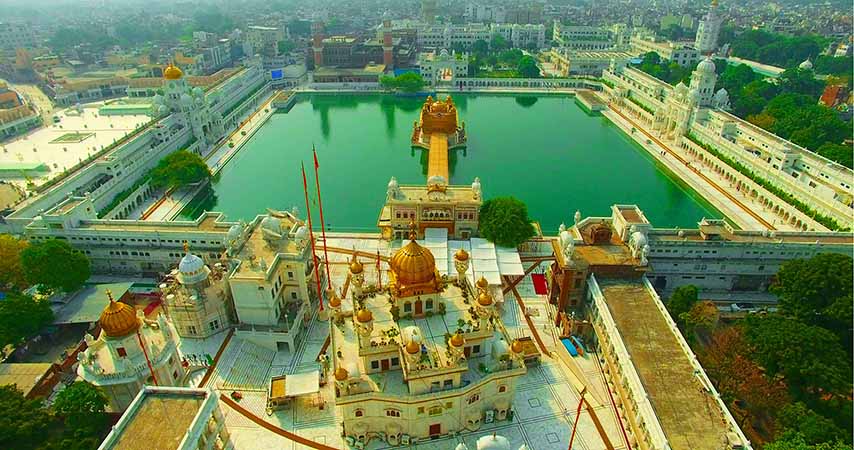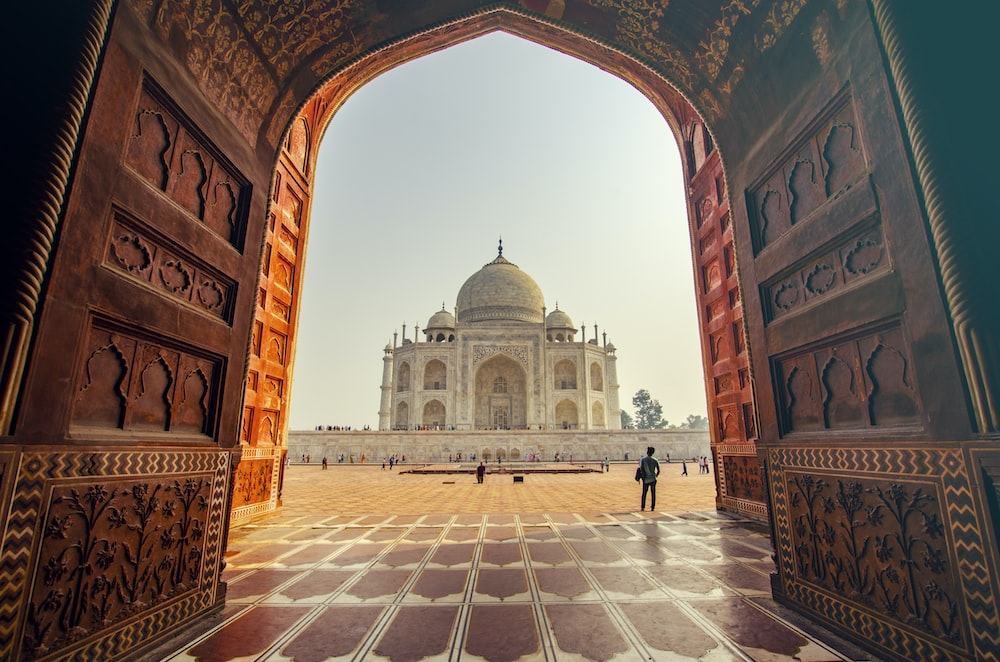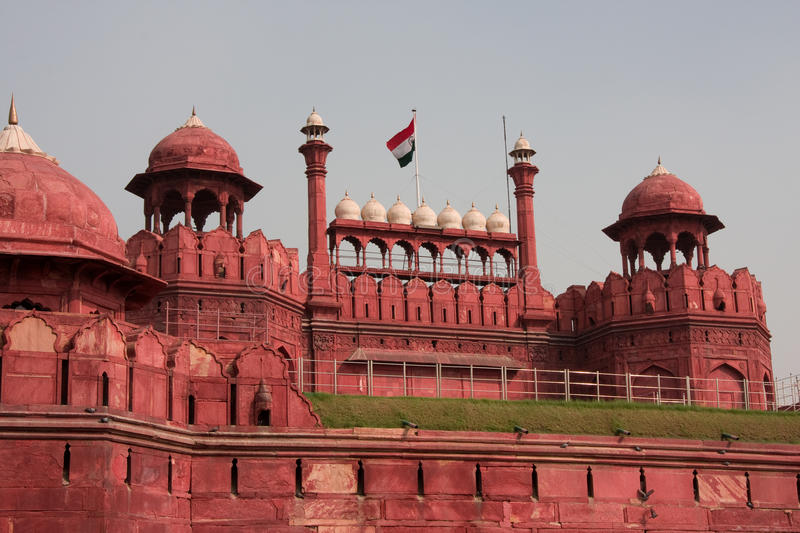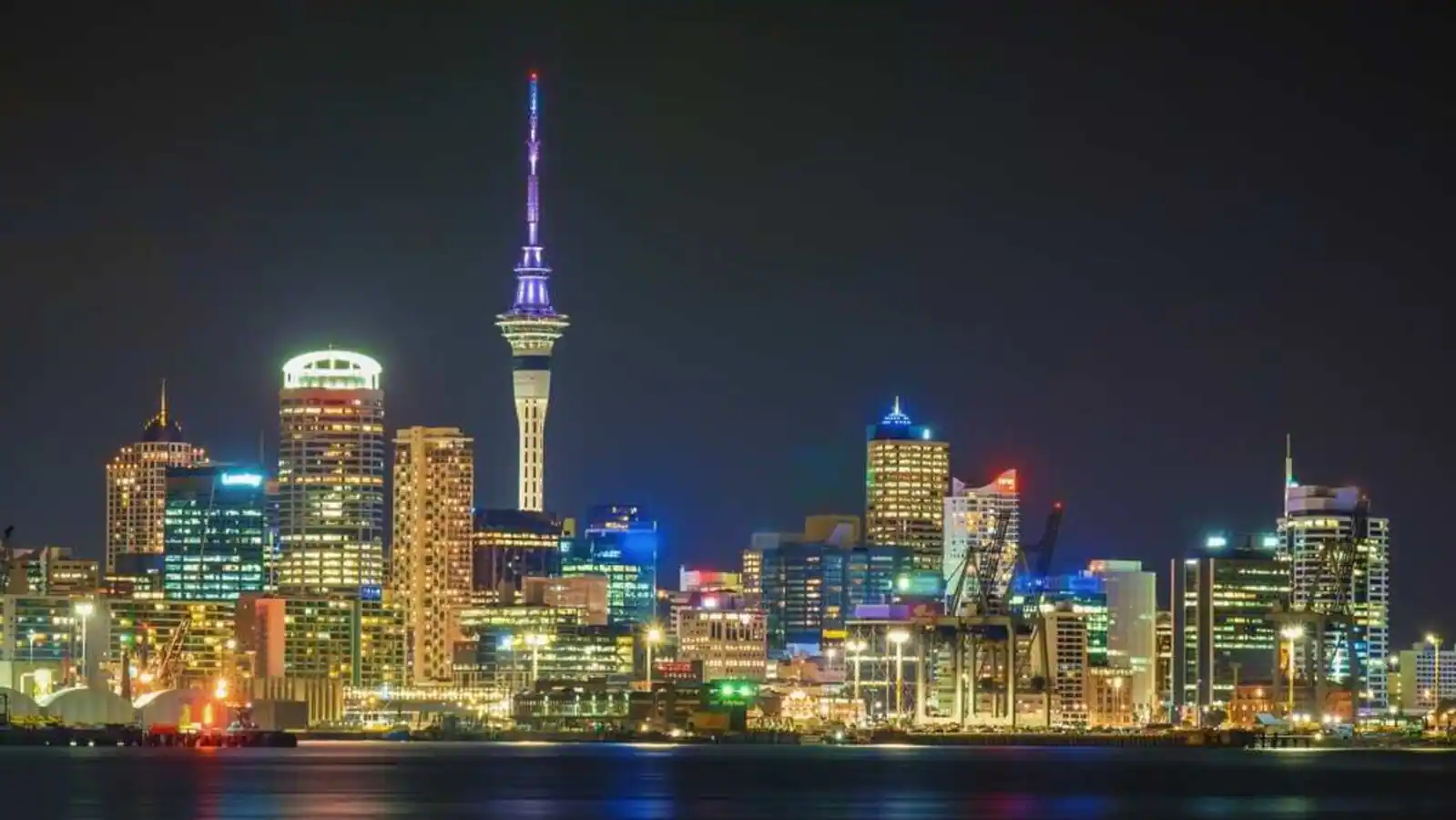AMRITSAR
Amritsar is one of the most visited places in the world, with nearly 1 lakh tourists visiting the Golden Temple every day. The name “Amritsar” is a combination of the words “Amrit and Sarovar” meaning ‘pool of nectar’. The Golden Temple, which shimmers in the middle of the sarovar, is the most sacred shrine for people of all faith and particularly the Sikhs across the world.
The city of Amritsar is also a thriving center of industry. It is famous for textile industry producing shawls and carpets. The traditional delicacies of Amritsar like Amritsari Kulchas, Chhole Bhature, Tandoori Chicken, Amritsari Fish, Peda-Lassi and many more delectable specialties are delights for gastronomes’.
Catering to tourists from across the world, Amritsar has a lot more to offer – especially glimpses of the life & times of ancient legends through historical monuments, temples, ancient bazaars and colorful festivals.
Golden Temple Amritsar
The history of the Golden Temple also known as Harmandir Sahib dates back to the 16th century when Sri Guru Amar Das Ji, the third Sikh Guru, purchased the land, it stands on from the Mughal Emperor Akbar. A tank was excavated at the site by fourth Sikh Guru, Sri Guru Ram Das Ji, and it came to be known as Guru ka Chak or Chak Ramdaspur. The fifth Sikh Guru, Sri Guru Arjan Dev Ji, started the construction of the Golden Temple in the late 16th century to house Sri Guru Granth Sahib the holy scripture of Sikhism. His son Sri Guru Hargobind Singh Ji, the sixth Sikh Guru, built Sri Akal Takht Sahib in the complex in 1606, representing both spiritual and temporal authority. After it’s destruction by the Mughal rulers in the 18th century, Maharaja Ranjit Singh undertook major works of renovation of Sri Harmandir Sahib with marble and copper in 1809. In the year 1830, the Maharaja donated large quantity of gold to overlay on the sanctum and thus came to be known as Golden Temple.
A blend of Hindu & Islamic architectural styles, Sri Harmandir Sahib, or the Golden Temple is located in the heart of the city where pilgrims of all faith from all over the world come to seek blessings of the divine and experience a sense of peace and serenity. The Golden Temple has four entrances, symbolizing its openness to people of all caste, creed, colour or religion. The Holy tank or Sarovar surrounding Sri Harmandir Sahib is believed to have healing powers which draw people from around the world to experience its touch for themselves.
Timings: Open throughout the day and night
Interpretation Centre (Golden Temple Complex)
Showcasing Sikh history and the significance of the Golden Temple, this fascinating and interactive multimedia museum is located underground in the premises of the Golden Temple Complex. The Interpretation Centre has four galleries each projecting 15-minute videos. One can visit the Interpretation Centre to have basic knowledge about Sikh religion and a better understanding of the Golden Temple and its importance.
English-translation headsets are available here free of cost.
Timings: 9 am to 4 pm
Town Hall – Partition Museum Amritsar
Town Hall – Partition Museum is the world’s first ever Partition Museum, depicting the pain and agony of the India-Pakistan partition of 1947. It features 14 galleries showcasing various phases of Partition, beginning with the years leading up to the historical event. Visitors can see photographs, newspaper clippings, donated personal belongings & letters of the victims of the partition. The visitor may also leave a message at the ‘Gallery of Hope’ built in the museum.
Timings: 10 am to 6 pm (Monday closed)
Entry Fee: Rs. 10 for Indians & Rs. 250 for foreigners
Jallianwala Bagh Amritsar
At a short distance from the Golden Temple, stands the national monument of Jallianwala Bagh, which has a significant place in the history of India’s freedom struggle. A large number of innocent men, women, and children were shot dead at this place under the orders of Brigadier-General Reginald Dyer on 13th April 1919, when they gathered there on Baisakhi day (also known as the Sikh New Year) to protest peacefully against the British Government’s draconian Rowlatt Act.
The bullet-marked walls and the well inside the garden, bear testimony to the sacrifices made by people in the freedom struggle. A large number of men, women, and children are known to have jumped into the well in a desperate attempt to escape the bullets fired by the British soldiers.
Timings: 6:30 am to 7 pm (April-September) & 7 am to 6 pm (October-March)
Entry is free
Sri Durgiana Temple Amritsar
Located roughly at a distance of about one and a half kilometers from the Golden Temple, Durgiana Temple is dedicated to the Hindu Goddess and is also known as the Laxmi Narayan Temple. Situated near Lohgarh gate in Amritsar, Durgiana Temple shares many architectural influences with the Golden Temple and is a popular shrine in Hinduism. Originally built in the 16th century, the temple was rebuilt in 1921 by Guru Harsai Mal Kapoor in the architectural style of the Golden Temple. A large number of devotees visit the temple every day to seek divine blessings.
Timings: 5.15 am to 1 pm (Morning) & 3 pm to 9 pm (Evening)
Heritage Street Amritsar
Bright lamp-posts, huge statues and fountains, inspired by Mughal, Rajputana and Sikh architecture dot the 1 km stretch from Town Hall to Sri Harmandir Sahib known as ‘Heritage Street’. The façades of all the buildings located on Heritage Street have a unique thematic look with a pinkish tone, turning the street into one huge monument featuring ancient signboards. Gurbani Kirtan is telecast live from Sri Harmandir Sahib on a large LED screen installed here. When visiting Harmandir Sahib in the late evening hours, visitors can experience Heritage Street in all its glory, illuminated with bright ambient lighting. A replica of the Indian Parliament house along with a statue of Dr. B R Ambedkar near Town Hall makes every Indian proud. The Heritage Street also features a large statue of Maharaja Ranjit Singh, founder of the Sikh Empire, as well as a marble statue dedicated to the memory of brave civilians who sacrificed their lives in Jallianwala Bagh.
Gobindgarh Fort Amritsar
The historic Gobindgarh Fort is located just a few kilometers away from the Golden Temple, in the heart of Amritsar. The historic fort was originally built in the 1760s by Gujjar Singh Bhangi and later rebuilt by Maharaja Ranjit Singh in the early 19th century.
Earlier known as “Bhangian da Killa” the fort was under the control of the Indian army, until it was made open to the public after a massive restoration and conservation works. It showcases exhibitions of Sikh martial history as well as the treasury of Maharaja Ranjit Singh. Gobindgarh Fort also serves as a theme park with numerous tourist attractions such as Tosha khana coin museum, Haat bazaar, Whispering Walls – a projection mapping show, spirit of Punjab live shows, and the Ambarsari Zaika resturaunt serving authentic Amritsari delicacies add to the experience. Visit the fort in the evening to witness all shows and make the most of your trip to the fort.
One unique attraction to experience at the fort is ‘Sher-e-Punjab’ (Lion of Punjab), which is a 15-minute 7D film about the life of Maharaja Ranjit Singh.
Fort Timings: Monday to Sunday 10 am to 10 pm
Entry Fee: Rs. 180 to Rs. 649 for Indians, Rs 250 to Rs 1000 for Foreigners*
Whispering Walls Projection Mapping Show: 7.15 pm (Punjabi) & 7.45 pm (English)
Sher-e-Punjab 7D Film: Throughout the day
Spirit of Punjab Live show: Throughout the day
(*The rates applicable at the time of visit may differ)
Khalsa College Amritsar
Khalsa College has a 300-acre campus, which is located at a distance of about 5 km from the Golden Temple. Built in 1892 by the famous architect, Bhai Ram Singh Ji, it is amongst the finest educational institutes opened during the British Rule in India.
With awe-inspiring architecture and eye-catching structures, Khalsa College resembles a huge palace and is often used as a shooting location for Bollywood & pollywood movies. Blockbuster films ‘Veer Zara’ & ‘Rab ne Bana di Jodi’ and many movies have been shot here.
Attari – Wagha Border Amritsar
The retreat ceremony at Attari-Wagah Border evokes a sense of enthusiasm and patriotism in every visitor as Indian Border Security Force Jawans & Pakistani Rangers stand face to face during the flag lowering ceremony held every evening. Huge crowd gather to witness and cheer for the Jawans (soldiers) of the Border Security Force as they perform spirited drills. The crowd heartily responds with patriotic slogans like ‘Bharat Mata Ki Jai’ and ‘Jai Hind’. Patriotic songs are also played before the ceremony begins. In order to get a convenient seat with an unhindered view of the entire drill ceremony, visitors are recommended to reach the gallery at least 45 minutes prior to the ceremony.
Timing: 4.30 pm to 5.30 pm (October-March) & 6.30 pm to 7.30 pm (April-September)
Entry is free.

Sadda Pind Amritsar
Saada Pind (our village) is a living village museum of Punjabi culture spread across 12 acres of land, set up to showcase the true essence of the region through its culture, traditions, colours and flavours. Visitors can connect with the roots of Punjabi culture and gain a deeper understanding of its values.
Situated at a distance of about 8 km from the Golden Temple, Saada Pind offers a hands on experience of rural life in Punjab through cultural performances, folk dances, local handicrafts, songs, stories and cuisine.
It also boasts of 20 spacious and comfortable guest rooms, where one can stay and immerse themselves in the experience of a typical Punjabi village.
Timings: 10.30 am to 10 pm
Entry Fee: Adults -Rs. 720 & Children-Rs. 570*
(*The rates applicable at the time of visit may differ)
Bhagwan Valmiki Tirath Sthal (Sri Ram Tirath) Amritsar
The birth place of two sons of Lord Rama and Mata Sita, Luv and Kush, and the ashram ofBhagwan Valmiki ji, Sri Ram Tirath Sthal is located 11 km away from Golden Temple. It is believed to be the place where Bhagwan Valmiki Ji wrote the epic ‘Ramayana’.
The shrine has been given a new look with a beautiful temple in the middle of a sarovar, housing the gold-plated statue of Bhagwan Valmiki Ji. Nearly two kilometers long parikarma goes around the main temple. The hut believed to be the birthplace of Luv & Kush is a highly popular attraction amongst visitors.
Timings: 6 am to 10 pm
Entry is Free


Punjab State War Heroes Memorial & Museum Amritsar
Dedicated to the brave heroes of the state, the Punjab State War Heroes Memorial & Museum is situated about 11 km away from Golden Temple. In the forecourt of the memorial a 45-meter-long sword soars high into the sky with four lion heads at the base, symbolizing the courage and fearlessness of Punjab’s proud warriors and its martial traditions.
The museum also houses memorabilia from important historical moments in wars fought by India, all the way from the period of Maharaja Ranjit Singh up to the Kargil War fought in 1999. A bunker-shaped café and a 7D theatre screening films about key battles fought in 1965 & 1971 make the museum an enriching experience for the visitors. The galleries inside the museum display unique artifacts related to Maharaja Ranjit Singh and the battles fought by him.
Timings: 9.30 am to 6.30 pm (April-September) & 10 am to 5.30 pm (October-March)
Entry is Free
Hop-on, Hop-off Bus Amritsar
For visitors seeking to enjoy various sights of the city of Amritsar in a cost-effective manner, the city’s Hop-on Hop-off Bus service is the perfect choice. The bus takes visitors to many popular attractions in Amritsar with plenty of time to see, enjoy and learn. Services of a tour guide is also being provided in the bus.
Ticket charges are Rs.250 per trip with 50% concession for senior citizens and children below the age of
(*The rates applicable at the time of visit may differ)
Pul Kanjri (Pul Moran) Amritsar
A heritage site built by Maharaja Ranjit Singh, Pul Kanjri is a historical monument located near village Dhanoa Kalan on the Indo-Pak border, approx. 36 km from Sri Harmandir Sahib. During the reign of Maharaja Ranjit Singh, it served as an important trading center and a resting place for travelling troops.
Pul Kanjri or Pul Moran showcases the secular history of Maharaja Ranjit Singh’s kingdom, featuring a Temple, a Gurudwara, a Mosque, and a bathing tank. It is also home to a monument built in memory of the soldiers who lost their lives in the 1971 war with Pakistan.

Attari Samadhan Amritsar
Attari Samadha Complex near the Indo-Pakistan international border is home to the Samadhi of Sardar Sham Singh Attariwala, known as a valiant general of Maharaja Ranjit Singh.
Sarai Amanat Khan Amritsar
Sarai Amanat Khan was built in 1640 by Amanat Khan, a Persian calligrapher and royal librarian in the Mughal court of the ruler. The name of the sarai near Tarn Taran district has been given after the name of Amanat Khan, who is also known for his inscriptions on the Taj Mahal, one of the seven wonders of the world.
Lahori Darwaza and Dilli Darwaza, are the two gateways that lead into a large open courtyard that houses a mosque, a well and a makeshift stable.
Amritsar Heritage Walk
This foray into the rich architectural and traditional heritage of Amritsar includes numerous katras, akharas, bungas, havelis and hattis. The Amritsar Heritage Walk tour starts from the historic Town Hall and ends at the Galleria at Sri Harmandir Sahib. It is about 45 minutes’ walk in the narrow lanes of Amritsar, where one can enjoy the façade of the buildings of Maharaja Ranjit Singh era.
Ram Bagh Palace
A peaceful and picturesque palace surrounded by rare plants, trees and water channels; Ram Bagh Palace served as the summer palace of Maharaja Ranjit Singh. It is named in the honour of the fourth Sikh Guru, Sri Guru Ram Das ji. Ram Bagh Palace features four huge gateways (deoris) built in the Punjabi architectural style with an influence of Rajasthani architecture. The palace now serves as a museum displaying several artefacts related to the life of Maharaja Ranjit Singh, including paintings, miniatures, and coins, as well as personal belongings such as his sword, shield, and more. The Museum also displays replicas of Maharaja Ranjit Singh’s golden throne and the famous Kohinoor diamond as an attraction for visitors.
Panorama Amritsar
A permanent visual documentation of the life of Maharaja Ranjit Singh, the Panorama is situated close to the Ram Bagh Palace, also known as the Maharaja Ranjit Singh Museum. The Panorama’s main attraction depicts six of the greatest battles of his lifetime. Other attractions include life-size paintings and diagrams showcasing the early life of Maharaja Ranjit Singh.
Thatheras of Jandiala Guru Amritsar
The Thatheras of Jandiala Guru is a community of skilled craftsmen known the world over for their traditional technique of making exquisitely hand-crafted brass, copper, and bell metal utensils by hammering metal sheets. Their craft holds the distinction of being India’s first inclusion in UNESCO’s Representative List of the Intangible Culture Heritage of Humanity in 2014.
For Information please Visit the official website of Punjab Tourism Govt of Punjab https://punjabtourism.punjab.gov.in
























Leave a Reply